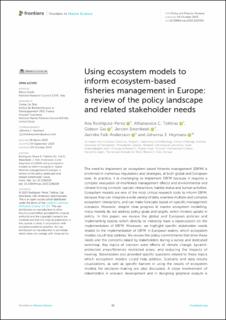| dc.contributor.author | Rodriguez-Perez, Ana | |
| dc.contributor.author | Tsikliras, Athanassios C. | |
| dc.contributor.author | Gal, Gideon | |
| dc.contributor.author | Steenbeek, Jeroen | |
| dc.contributor.author | Falk-Andersson, Jannike | |
| dc.contributor.author | Heymans, Johanna J. | |
| dc.date.accessioned | 2023-11-15T10:01:44Z | |
| dc.date.available | 2023-11-15T10:01:44Z | |
| dc.date.created | 2023-11-08T10:43:49Z | |
| dc.date.issued | 2023 | |
| dc.identifier.citation | Frontiers in Marine Science. 2023, 10:1196329. | en_US |
| dc.identifier.issn | 2296-7745 | |
| dc.identifier.uri | https://hdl.handle.net/11250/3102673 | |
| dc.description.abstract | The need to implement an ecosystem-based fisheries management (EBFM) is enshrined in numerous regulations and strategies, at both global and European level. In practice, it is challenging to implement EBFM because it requires a complex evaluation of interlinked management effects and environmental and climate forcing on multi-species interactions, habitat status and human activities. Ecosystem models are one of the most critical research tools to inform EBFM, because they can integrate a wide variety of data, examine multiple and complex ecosystem interactions, and can make forecasts based on specific management scenarios. However, despite clear progress in marine ecosystem modelling, many models do not address policy goals and targets, which hinders uptake in policy. In this paper, we review the global and European policies and implementing bodies which directly or indirectly have a repercussion on the implementation of EBFM. Moreover, we highlight specific stakeholder needs related to the implementation of EBFM in European waters, which ecosystem models could help address. We review the policy commitments that drive these needs and the concerns raised by stakeholders during a survey and dedicated workshop. Key topics of concern were effects of climate change; bycatch; protected areas/fisheries restricted areas; and reducing the impacts of trawling. Stakeholders also provided specific questions related to these topics which ecosystem models could help address. Scenario and data results visualizations, as well as specific barriers in using the results of ecosystem models for decision-making are also discussed. A close involvement of stakeholders in scenario development and in designing graphical outputs is important, and can help overcome some of the main barriers that can hinder uptake of models and scenarios, including a lack of understanding of the benefits and limits of ecosystem models; insufficient involvement and interaction with stakeholders; and inadequate characterization of uncertainties. | en_US |
| dc.language.iso | eng | en_US |
| dc.publisher | Frontiers | en_US |
| dc.rights | Navngivelse 4.0 Internasjonal | * |
| dc.rights.uri | http://creativecommons.org/licenses/by/4.0/deed.no | * |
| dc.title | Using ecosystem models to inform ecosystem-based fisheries management in Europe: a review of the policy landscape and related stakeholder needs | en_US |
| dc.type | Peer reviewed | en_US |
| dc.type | Journal article | en_US |
| dc.description.version | publishedVersion | en_US |
| dc.rights.holder | © 2023 The Authors | en_US |
| dc.source.pagenumber | 0 | en_US |
| dc.source.volume | 10 | en_US |
| dc.source.journal | Frontiers in Marine Science | en_US |
| dc.identifier.doi | 10.3389/fmars.2023.1196329 | |
| dc.identifier.cristin | 2193752 | |
| dc.source.articlenumber | 1196329 | en_US |
| cristin.ispublished | true | |
| cristin.fulltext | original | |
| cristin.qualitycode | 1 | |

